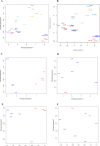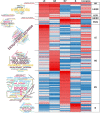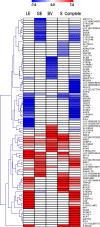Spatial organization of endometrial gene expression at the onset of embryo attachment in pigs
- PMID: 31752681
- PMCID: PMC6873571
- DOI: 10.1186/s12864-019-6264-2
Spatial organization of endometrial gene expression at the onset of embryo attachment in pigs
Abstract
Background: During the preimplantation phase in the pig, the conceptus trophoblast elongates into a filamentous form and secretes estrogens, interleukin 1 beta 2, interferons, and other signaling molecules before attaching to the uterine epithelium. The processes in the uterine endometrium in response to conceptus signaling are complex. Thus, the objective of this study was to characterize transcriptome changes in porcine endometrium during the time of conceptus attachment considering the specific localization in different endometrial cell types.
Results: Low-input RNA-sequencing was conducted for the main endometrial compartments, luminal epithelium (LE), glandular epithelium (GE), blood vessels (BV), and stroma. Samples were isolated from endometria collected on Day 14 of pregnancy and the estrous cycle (each group n = 4) by laser capture microdissection. The expression of 12,000, 11,903, 11,094, and 11,933 genes was detectable in LE, GE, BV, and stroma, respectively. Differential expression analysis was performed between the pregnant and cyclic group for each cell type as well as for a corresponding dataset for complete endometrium tissue samples. The highest number of differentially expressed genes (DEGs) was found for LE (1410) compared to GE, BV, and stroma (800, 1216, and 384). For the complete tissue, 3262 DEGs were obtained. The DEGs were assigned to Gene Ontology (GO) terms to find overrepresented functional categories and pathways specific for the individual endometrial compartments. GO classification revealed that DEGs in LE were involved in 'biosynthetic processes', 'related to ion transport', and 'apoptotic processes', whereas 'cell migration', 'cell growth', 'signaling', and 'metabolic/biosynthetic processes' categories were enriched for GE. For blood vessels, categories such as 'focal adhesion', 'actin cytoskeleton', 'cell junction', 'cell differentiation and development' were found as overrepresented, while for stromal samples, most DEGs were assigned to 'extracellular matrix', 'gap junction', and 'ER to Golgi vesicles'.
Conclusions: The localization of differential gene expression to different endometrial cell types provided a significantly improved view on the regulation of biological processes involved in conceptus implantation, such as the control of uterine fluid secretion, trophoblast attachment, growth regulation by Wnt signaling and other signaling pathways, as well as the modulation of the maternal immune system.
Keywords: Cell type-specific; Endometrium; LCM; LMD; Pig; Preimplantation; RNA-seq; Transcriptomics.
Conflict of interest statement
The authors declare that they have no competing interests.
Figures





Similar articles
-
Cell type-specific analysis of transcriptome changes in the porcine endometrium on Day 12 of pregnancy.BMC Genomics. 2018 Jun 14;19(1):459. doi: 10.1186/s12864-018-4855-y. BMC Genomics. 2018. PMID: 29898663 Free PMC article.
-
Transcriptome changes in the porcine endometrium during the preattachment phase.Biol Reprod. 2013 Dec 12;89(6):134. doi: 10.1095/biolreprod.113.112177. Print 2013 Dec. Biol Reprod. 2013. PMID: 24174570
-
Integrating LCM-Based Spatio-Temporal Transcriptomics Uncovers Conceptus and Endometrial Luminal Epithelium Communication that Coordinates the Conceptus Attachment in Pigs.Int J Mol Sci. 2021 Jan 27;22(3):1248. doi: 10.3390/ijms22031248. Int J Mol Sci. 2021. PMID: 33513863 Free PMC article.
-
Biology of progesterone action during pregnancy recognition and maintenance of pregnancy.Front Biosci. 2002 Sep 1;7:d1879-98. doi: 10.2741/spencer. Front Biosci. 2002. PMID: 12161340 Review.
-
Implantation in the baboon: endometrial responses.Semin Reprod Endocrinol. 1999;17(3):257-65. doi: 10.1055/s-2007-1016233. Semin Reprod Endocrinol. 1999. PMID: 10797944 Review.
Cited by
-
Matrix metalloproteinases: expression and regulation in the endometrium during the estrous cycle and at the maternal-conceptus interface during pregnancy in pigs.Anim Biosci. 2023 Aug;36(8):1167-1179. doi: 10.5713/ab.22.0478. Epub 2023 May 2. Anim Biosci. 2023. PMID: 37170522 Free PMC article.
-
Endometrial DNA methylation signatures during the time of breeding in relation to the pregnancy outcome in postpartum dairy cows fed a control diet or supplemented with rumen-protected methionine.Front Genet. 2024 Jan 24;14:1267053. doi: 10.3389/fgene.2023.1267053. eCollection 2023. Front Genet. 2024. PMID: 38327702 Free PMC article.
-
Spatiotemporal endometrial transcriptome analysis revealed the luminal epithelium as key player during initial maternal recognition of pregnancy in the mare.Sci Rep. 2021 Nov 16;11(1):22293. doi: 10.1038/s41598-021-01785-3. Sci Rep. 2021. PMID: 34785745 Free PMC article.
-
Identification of Differentially Expressed Gene Transcripts in Porcine Endometrium during Early Stages of Pregnancy.Life (Basel). 2020 May 16;10(5):68. doi: 10.3390/life10050068. Life (Basel). 2020. PMID: 32429378 Free PMC article.
-
Distinct traces of mixed ancestry in western commercial pig genomes following gene flow from Chinese indigenous breeds.Front Genet. 2023 Jan 13;13:1070783. doi: 10.3389/fgene.2022.1070783. eCollection 2022. Front Genet. 2023. PMID: 36712875 Free PMC article.
References
-
- Geisert RD, Bazer, Fuller W . Implantation and Establishment of Pregnancy in the Pig. In: Regulation of Implantation and Establishment of Pregnancy in Mammals: Tribute to 45 Year Anniversary of Roger V. Short's "Maternal Recognition of Pregnancy", Advances in Anatomy, Embryology and Cell Biology 216. Switzerland: Springer International Publishing; 2015. - PubMed
MeSH terms
Grants and funding
LinkOut - more resources
Full Text Sources
Molecular Biology Databases
Miscellaneous

